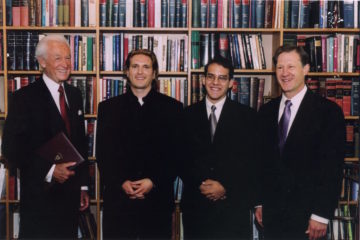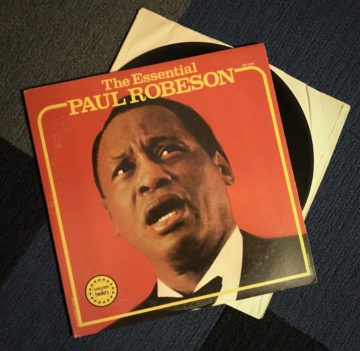
Elmgreen and Dragset. The Painter Fig 1, 2021.
Thanks to Jaffer Kolb and Ingar Dragset.
by Jochen Szangolies

Children, they say, are natural scientists (although opinion on what it is that makes them so appears divided). Each of us has probably been stumped by a question asked, out of the blue, that gives a sudden glimpse into the workings of a mind encountering the world for the first time, faced with the impossible task of making sense of it. While there may be an element of romanticisation at play, such moments also, on occasion, show us the world from a point of view where the assumptions that frame the adult world have not yet calcified into comforting certainties.
The questions I asked, as a child, where probably mostly of the ‘neverending chain of why’-sort (a habit I still haven’t entirely shed). But there was one idea that kept creeping up on me with an almost compulsive quality: how do I know what’s inside things? Is there anything, or is there just a dark nothing behind their flimsy outer skin? Granted, I probably didn’t phrase it in these terms, but there was a sort of vaguely realized worry that things might just suddenly go pop like an unsuspecting balloon pricked by a prankster’s needle, exposing themselves as ultimately hollow, mere shells.
It’s not such an easily dismissed idea. All we ever see of things are surfaces reflecting light. All we ever touch are exteriors. Even the tasting tongue, a favorite instrument of probing for the curious child, tastes nothing but what’s on the outside (incidentally, here’s something I always found sort of creepy: look at anything around you—your tongue knows exactly what it feels like).
You might think it’s a simple enough exercise to discover the inner nature of things—faced with, say, the deliciously decorated exterior of a cake, in the best analytic tradition, heed your inner lobster, whip out a knife and cut right into it to expose the sweet interior. But are you then truly faced with the cake’s inner nature? No—rather, you’re presented with the surface of the piece you cut out, and the rest remaining on the cake platter.
The act of cutting, rather than revealing the inner, just creates new exterior, by separating the cut object—you can’t cut your cake and leave it whole. Whenever threatened with exposure, the inner retreats behind fresh surface. Read more »
by Joseph Shieber

I first became aware of the historian Allen Guelzo’s work due to a mention in a recent newspaper column — just not the mention that, if you’re active on Twitter (and particularly philosophy Twitter), you might be expecting.
In a glowing review in the Washington Post, George Will praised Guelzo’s new biography of Robert E. Lee for Guelzo’s unwillingness to buy in to the hagiography associated with the reverence for Lee that characterized so many 20th century assessments.
Here’s a sample:
Lee, Guelzo writes, “raised his hand” against the nation that, as an Army officer, he had sworn to defend. He did so for an agenda that a much greater man, Ulysses S. Grant, called one of “the worst for which a people ever fought.” Lee thought slavery was a “greater evil” to White people than to Black people. He enveloped himself in what Guelzo calls a “cloud of pious wishes” and decided, as Guelzo tartly says, “it was up to the whites to decide when enough was enough.” Guelzo writes that to Lee, slavery’s victims were “invisible, despite their presence all around.” His indifference was “cruelty in self-disguised velvet.” Not well disguised, when he presided at the whipping of three recaptured runaways, ordering a constable to “lay it on well.”
Given the care that Guelzo obviously devotes to getting the details right in his widely praised historical works, it was surprising for me to see that he was being roasted on Twitter for some glaringly inaccurate pronouncements on Kant.
The impetus for the derision being heaped on Guelzo was a column — again in the Washington Post — in which Marc Thiessen attempted “to explain CRT [Critical Race Theory] and why it is so dangerous”. Read more »
by Brooks Riley

by Omar Baig

Chris Green is the Executive Director of Harvard Law School’s Animal Law & Policy Program; the former Chair of the American Bar Association’s Animal Law Committee; and previously was the Director of Legislative Affairs for the Animal Legal Defense Fund. In those capacities, Green persuaded the top three US airlines to stop transporting endangered animal hunting trophies, helped defeat Ag-Gag legislation in several states, and passed two ABA resolutions that recommended 1) outlawing the possession of dangerous wild animals, and 2) providing non-lethal animal encounter training to officers. He recently served on a National Academies of Sciences committee, which recommended that the Dept. of Veterans Affairs substantially reduce its use of dogs in biomedical research. Green is a graduate of Harvard Law School and the University of Illinois: where he created the college’s first Environmental Science degree. He also works in the fine arts, film, and music industries, producing several documentaries, including the film Of Dogs and Men about police shooting people’s pets.
Congratulations on the news of a $10 million endowment for the Animal Law & Policy Program by the Brooks Institute. Could you discuss the Harvard Law School’s previous and ongoing collaboration with the Brooks Institute, like the Brooks Animal Law Digest?
Four years ago, Professor Kristen Stilt, the Animal Law & Policy Program’s Faculty Director, and I met with the Brooks Institute’s Executive Director, Tim Midura. The two of us offered our knowledge and experience to help strategize how the greatest impact could be made. Kristen then became one of the Brooks Institute’s advisers––serving on its Executive Committee, Scholars Committee, and the Leadership Committee of both the Brooks Animal Studies Academic Network and the Brooks Animal Sentience and Cognition Initiative.
We could not be prouder to have our work recognized in this manner and are honored that our Program will now bear the name of Brooks McCormick Jr.––who cared so deeply about the treatment of nonhuman animals. Read more »
by Dick Edelstein

This is the second of three articles on the theme of historical memory. The first, which can be found here, deals with issues related to archival data on casualties and victims in the Spanish Civil War. In the present article, I discuss the activities of a movement to redress the exclusion of Irish women writers from the historical record.
Fired! Irish Women Poets and the Canon is a collective that became publicly known in 2017. It emerged from discussions among a group of women of varied backgrounds in both Northern Ireland and the Republic who shared a common interest in the status of women in the arts, and it was launched in response to the publication of the current edition of the Cambridge Companion to Irish Poetry, an authoritative compendium that is re-published periodically in updated editions.
The exclusion of women in that volume and others like it was neither remarkable nor novel; what was noteworthy on this occasion was the existence of a body of recently published research on the careers of a number of successful Irish women poets in the 18th, 19th and early 20th centuries. (A notable example is Poetry by Women in Ireland: A Critical Anthology 1870-1970 by Dr. Lucy Collins.) This research brought to light the poetry of several Irish women who had enjoyed important reputations in the past. The Cambridge volume ignored this research, and just four of its thirty chapters were devoted to female writers, while only four female critics had been commissioned to provide chapters.
The response was the launch of Fired! Irish Women Poets and the Canon through two lines of action: a pledge aimed at redressing the gender imbalance in Irish poetry and a series of readings throughout Ireland and abroad to focus attention on historical Irish women poets. Read more »
Last week, my wife and I were in Amsterdam for a couple of days. The historic house we were staying in, called Castrum Peregrini, belonged to the artist Gisèle d’Ailly van Waterschoot van der Gracht who hid two Jewish people in it from the Nazis during WWII. This is one of her paintings that the head of the foundation which takes care of the house showed us as part of a tour of the house. The painting is quite compact when folded but unfolds like this to reveal three additional panels, as its size triples. More about the artist here.
by Alexander C. Kafka
 Tick, Tick . . . Boom! is a lively, lovely tribute by one singular Broadway talent, Lin-Manuel Miranda, to another, Jonathan Larson. It also marks Miranda’s impressive debut as a film director.
Tick, Tick . . . Boom! is a lively, lovely tribute by one singular Broadway talent, Lin-Manuel Miranda, to another, Jonathan Larson. It also marks Miranda’s impressive debut as a film director.
Not to get all sappy or anything, but beyond its superb casting and production standards, the movie brims with love. Love for Larson, who died tragically and prematurely from an aortic aneurysm at age 35 the day before the opening of his magnum opus, Rent. But love too for the creative impulse and the artistic life. Folks who hate musicals, who find too many characters nauseatingly self-involved, will not find counterevidence here. But that self-involvement is a plot-driver in Boom!, a trait analyzed and criticized but clearly necessary to the pursuit of a poetic project against all odds and societal pressures.
The film is based on a 1990 solo show — a “rock monologue” — that Larson performed about his experiences with a previous, unproduced musical called Superbia. After Larson’s death, playwright David Auburn revamped Boom! as a three-actor script. In this film version, Steven Levenson frames the story using Larson’s future Rent success. That’s a smart move. It casts Boom! as an origin story of sorts, with the poignant, bittersweet light of laurels to come, but also of fate’s cruel hand. The Tick, Tick … Boom! of a career as the Larson character approaches his 30th birthday is also the emptying of the hourglass of life, and the bomb countdown of a brave, delicate heart on a short biological fuse. Read more »
by Pranab Bardhan
All of the articles in this series can be found here.
 Of the senior professors at MIT other than Samuelson and Solow, I had a somewhat close relationship with Paul Rosenstein-Rodan, a pioneer in development economics. He had grown up in Vienna and taught in England before reaching MIT. He had advised governments in many countries, and was full of stories. In India he knew Nehru and Sachin Chaudhuri well. He had an excited, omniscient way of talking about various things. At the beginning of our many long conversations he asked me what my politics was like. I said “Left of center, though many Americans may consider it too far left while several of my Marxist friends in India do not consider it left enough”. As someone from ‘old Europe’ he understood, and immediately put his hand on his heart and said “My heart too is located slightly left of center”.
Of the senior professors at MIT other than Samuelson and Solow, I had a somewhat close relationship with Paul Rosenstein-Rodan, a pioneer in development economics. He had grown up in Vienna and taught in England before reaching MIT. He had advised governments in many countries, and was full of stories. In India he knew Nehru and Sachin Chaudhuri well. He had an excited, omniscient way of talking about various things. At the beginning of our many long conversations he asked me what my politics was like. I said “Left of center, though many Americans may consider it too far left while several of my Marxist friends in India do not consider it left enough”. As someone from ‘old Europe’ he understood, and immediately put his hand on his heart and said “My heart too is located slightly left of center”.
One of his many stories involved his trip to rural Egypt. He was traveling in the countryside in a car in the early evening. He saw a big field in one village where people were gathering for a cinema show; he stopped there, and as he walked closer to the place he saw that the large screen was made of rather thin paper. So he asked his Egyptian companion why it was paper, not the usual cloth screen; the latter asked him to wait, he’d soon know why. Then the film started, and sure enough it was a Bombay film, where at the beginning the villain was winning both in the fight scenes with the hero and also in the love scenes with the heroine. As this went on for some time the viewers were getting angrier and angrier, at one point they couldn’t take it anymore, they all stood up and with great fury started throwing their little knives at the screen, which soon got badly perforated. The projector was then stopped, and another paper screen was installed before the film could continue to its ultimate crowd-satisfying end. Read more »
by Michael Abraham-Fiallos
[This essay closes a loose trilogy of essays, which I did not quite comprehend as a trilogy until I finished it. The first can be read here, and the second can be read here. In closing the trilogy, which is focused on love and the queer, this essay acts a kind of coda, a lyrical “testing out” of the ideas that I proffer in the earlier essays’ readings of literature.]
Nighttime, and we’re on the bridge, my head leaning against the cab window, my head a swim of beer and love for you, for this life which I feel very distinctly just now, which I feel like heat on the skin. Skyline’s a huddle of gods, and you say, This is the only home we’ll ever know; and I say, Maybe we should move to L.A., to the beach; but I don’t mean it. I could not. I came out of the West with pine in my blood and luck in my pocket. I came out of the woods to live deliberately. I was mad with thirst, thirst for wind down wide avenues and the crush of serious people, serious people with their dollars for the homeless, with their failures and their triumphs and their magazines. I was going to see for myself the way the sun kisses the water towers in the evening. I was going to waste time in the Village and become a writer, that thing one is always going to be here. I was going to wear laurels on my head. I was going to know the places where the mad ones dwelt and bled out their mad novels, where the drugs and the liquor and the hard beat of the bass have flown for seemingly forever. And I have known these. I have known them well.
O—there is nothing in me but skyline, but long sprawl and tight crunch and a glint of vertigo off the rooftops. There is nothing left for me anywhere else anymore. I am a thorough current of electricity. I have been taken in by harsh talk and cheap pizza, by trash and chance and summer thunder. There is rushing here and rushing there in my days. The trundle of trains below the earth and on long jumbles of beams through the sky. Takeout food and the endlessness of other languages, their snatches like snatches of birdsong. The birds in the sickly trees, the parks starving against the concrete. The sluggish rivers unfit for swimming and the lust that washes into them like runoff at dawn, when the sun chases the revelers and the drunks off to bed. All this, and more too, leeches the pine from my blood. All this, and more too, makes a home in me. Read more »
by David Kordahl

The physicist Philip W. Anderson, winner of the Nobel Prize in 1977, has lingered in the broader scientific imagination for two main reasons—reasons, depending on your vantage, that cast him either as a hero, or as a villain.
The heroic Anderson is the author of “More Is Different,” the 1972 essay that wittily dismisses the idea that the laws of physics governing the microscopic constituents of matter are by themselves enough to capture the full richness of the world. His vision of science as a “seamless web” of interconnections led to his becoming one of the public faces of so-called “complexity science,” and a founding member of the Santa Fe Institute.
The villainous Anderson is remembered for taking this position—the position that the low-level laws of physics do not exhaust fundamental physics—in front of Congress. Anderson’s tart exchanges with Steven Weinberg before the Senate debating the merits of the Superconducting Super Collider (SSC) begin a new biography, A Mind Over Matter: Philip Anderson and the Physics of the Very Many, by Andrew Zangwill. When the SSC was canceled, Anderson, who argued that the funds would be better spent on a wider variety of projects, became a target of physicists’ ire, despite his lack of any significant political influence. (Weinberg’s last book of essays, which I reviewed, extensively discussed the politics of the SSC.)
But Anderson, who died just last year, was much more than just a hero or villain. A Mind Over Matter makes the case that Anderson was “one of the of the most accomplished and influential physicists of the twentieth century.” In presenting the evidence, Zangwill, who is himself a notable physicist, gives us a tour of condensed-matter physics, the science that deals with the properties of materials not atom-by-atom but roughly 1023 particles at a time, a subject where Anderson’s influence continues on. Read more »

overlooking a river rife with history that
runs along the bottom of an ancient gorge
between two mountains autumn rusts.
in yellows, russets, remnant greens,
drapes of leaves cascade down their opposing slopes
liquid as runoff, colors sluiced into the wide wet rush
of that streaming source of being
boiling white over rocks tumbling while
along its banks caught, serenely eddying in time cycles
intent …. dead set …. falling … moving … somewhere
Jim Culleny, 11/7/21
Photo by S. Abbas Raza
by Usha Alexander
[This is the fourteenth in a series of essays, On Climate Truth and Fiction, in which I raise questions about environmental distress, the human experience, and storytelling. All the articles in this series can be read here.]
 Our human story has never been simple or monotonous. In fact, it has been nothing less than epic. Beginning from relatively small populations in Africa, our ancestors traveled across the globe. As they went, they mastered new environments, even while those environments were continuously changing—sometimes in predictable cycles, sometimes unpredictably, as the planet wobbled in its orbit, the sun flared, a volcano blew, or other geophysical events transpired. Born during the ever-fluctuating conditions of the ice age, early humans soon mastered a great variety of adaptive living strategies. They combined cycles of nomadism and settlement. They fished, trapped, followed game herds, ambushed seasonal mass-kills, or even forbade the consumption of particular species at various times and places. They tended forests and grasslands with controlled fire, spread seeds, shifted cultivation, pruned and grafted trees, fallowed lands, and followed seasonal produce, among other techniques, managing their local environments and recognizing that their own wellbeing was intimately tied up with the health of local ecosystems. Through these practices, each community relied upon diets that included hundreds of species of edible plants and animals, from palm piths to pine needles, sea slugs to centipedes, mosses to mongooses—far beyond the foods we ordinarily think of today—and developed material cultures and pharmacopeias that might have included hundreds more. Such flexibility and breadth of environmental understanding promoted resiliency among what grew into a great diversity of peoples over hundreds of millennia, many of whom managed to steadily inhabit a particular region, maintaining an unbroken cultural continuity over hundreds of generations.
Our human story has never been simple or monotonous. In fact, it has been nothing less than epic. Beginning from relatively small populations in Africa, our ancestors traveled across the globe. As they went, they mastered new environments, even while those environments were continuously changing—sometimes in predictable cycles, sometimes unpredictably, as the planet wobbled in its orbit, the sun flared, a volcano blew, or other geophysical events transpired. Born during the ever-fluctuating conditions of the ice age, early humans soon mastered a great variety of adaptive living strategies. They combined cycles of nomadism and settlement. They fished, trapped, followed game herds, ambushed seasonal mass-kills, or even forbade the consumption of particular species at various times and places. They tended forests and grasslands with controlled fire, spread seeds, shifted cultivation, pruned and grafted trees, fallowed lands, and followed seasonal produce, among other techniques, managing their local environments and recognizing that their own wellbeing was intimately tied up with the health of local ecosystems. Through these practices, each community relied upon diets that included hundreds of species of edible plants and animals, from palm piths to pine needles, sea slugs to centipedes, mosses to mongooses—far beyond the foods we ordinarily think of today—and developed material cultures and pharmacopeias that might have included hundreds more. Such flexibility and breadth of environmental understanding promoted resiliency among what grew into a great diversity of peoples over hundreds of millennia, many of whom managed to steadily inhabit a particular region, maintaining an unbroken cultural continuity over hundreds of generations.
Alongside their diverse subsistence strategies, human societies also practiced an astonishing array of social and political institutions and arrangements—none of them ever amounting to a utopia—many of them difficult for us even to imagine today, with our impoverished templates of human possibility. They included fluid forms of power sharing that shifted ritually, seasonally, or otherwise, between generations, genders, lineages. Sometimes social power was more centralized; other times more distributed or opportunistic; sometimes more closely tied with wealth, but not usually. Read more »
by R. Passov
When I was in the fourth grade I was held in a class through recess, most likely because letting me on the black top usually resulted in a fight. I was particularly thin-skinned and couldn’t cope with being in perhaps the only place in late-1960’s Los Angeles where children had a sense of their permanence, or at least of a place above everyone else.
I had landed in that place – Beverly Hills – from the Los Felix section of LA, now trendy, then where  hookers rested after walking Hollywood Boulevard, or at least that’s what my mother once said of her counterparts who lived in rooms above the garages of a small apartment building on a busy street. While waiting for my father to return from prison, we lived in one of the garages, converted into a shelter.
hookers rested after walking Hollywood Boulevard, or at least that’s what my mother once said of her counterparts who lived in rooms above the garages of a small apartment building on a busy street. While waiting for my father to return from prison, we lived in one of the garages, converted into a shelter.
In hindsight, it’s not surprising that I couldn’t master a narrative that to those carefree, cruel Beverly Hills kids, made any sense. And so, day-after-day, at the slightest provocation, I lashed out.
Sitting in that room, in my detention, I vaguely remember doodling through a division problem, using a long-since forgotten technique. At some point, what then seemed an ancient person stood over my shoulder, hands behind her back, wearing a frock from head to toe.
“Here,” she said, “let me show you something.” She took what I had been working on and re-wrote it, straightening it into a column, keeping the smaller number to the left, housing the bigger number under a hand-drawn awning. When the picture was finished she patiently entered into a game of subtraction, finally ending in two smaller numbers that had much to do with where she had started.
There was a little magic in what she did. I was excited at how easily I was able to reproduce her game; tingling with a sense of playful power over what I could do simply for the nonsense of it. But the magic, I came to learn, was not in the math. Rather it was in her sympathetic eyes which, for a moment, tamed me. Read more »
by Rafaël Newman
Neapolitan conversation is impenetrable to outsiders. Ears, nose, eyes, breast and armpits are signal stations to be pressed into use by fingers, a distribution that recurs in the particular specializations of the local erotics. The foreigner is struck by so much solicitous gesturing and impatient touching, whose regularity rules out coincidence. And while the Neapolitan may betray him, even sell him out—yet in the end he bids the foreigner a good-humored addio: sends him on his way, a few kilometers down the road to the village of Mori. Vedere Napoli e poi Mori, says the Neapolitan, reciting an old joke. “See Naples and die,” echoes the German. —Walter Benjamin and Asja Lācis1

“The German,” among other foreigners, may perhaps be forgiven for reflexively associating Naples with death. There is the archaic quality of the city’s public superstition, present in the phallic horns everywhere for sale, said to be useful in warding off the fatal Evil Eye. There is the enormous hexagonal pile of the Castel Sant’Elmo looming over the city, its blank medieval walls threatening would-be invaders with doom; and there is its equally brooding partner on the harbor front, the Castel dell’Ovo, built, legend has it, upon a hidden Virgilian egg, whose fragile intactness is the only guarantee of the fortification’s survival. Just a little further afield, and ever present on the horizon, watching over all the many and varied rituals of daily life, is the sinisterly mammary double hulk of Vesuvius, mainland Europe’s only recently active volcano, an ominously smoking reminder, via the nearby ghost towns of Pompeii and Herculaneum, of a capricious and death-dealing nature. (Naples itself lies athwart the Phlegraean Fields, an area of volcanic activity under continuous seismographic surveillance.) And, shot through the entire place, invisible to the untrained eye save in the ubiquitous mounds of ostentatiously uncollected garbage, there is the loosely organized criminal society known as the Camorra, whose provision—or repression—of communal services, and whose targeted acts of violence to enforce its rule, have been mortally endangering the health of Neapolitans for centuries.
Walter Benjamin and Asja Lācis, in their 1925 essay on Neapolitan architecture, were unexpectedly downbeat about the city’s physical aspect, which, they maintained, does not provide the Mediterranean charm and balm for the eyes expected by the routine northern visitor: “Fantastical travelogues have colorized the city; in reality it is gray, a grayish red or ochre, a grayish white. And quite completely gray where it meets the sky and sea. This is not the least of the reasons for its citizens’ anhedonia. For if one has no eye for shapes, there is little to see here. The city is craggy. Seen from the heights, where the voices are unheard, from Castell San Martino, it lies extinct in the twilight, petrified.”2 And indeed, for all their vividness, the visual arts, as generously on display in Naples as in many other Italian cities, offer no more respite from this general air of memento mori (by which I do not mean a souvenir stand in the notorious neighboring village) than does its architecture. Read more »
by Michael Liss
 Do we Americans really have a shared, founding mythology that unites us in a desire to work together for the common good?
Do we Americans really have a shared, founding mythology that unites us in a desire to work together for the common good?
I wrote that, last month, in “The Coupist’s Cookbook,” and was challenged in an email by a friendly but dubious reader.
Is there a common history, a type of universal “origin story”? Does that make for a compact, of the type the signers of the Declaration of Independence acknowledged, when they pledged their “lives, fortunes, and sacred honor”? If so, aren’t we the heirs to that bundle of benefits and burdens? Finally, to explore further the implication of my correspondent’s email, if that “deal” no longer applies, how do we coexist and maintain a government in which we can freely express ourselves and choose, and change, our leaders?
I don’t have easy answers. I’ve written roughly a dozen pieces for 3Q in the last few years about Washington, Adams, Jefferson, Lincoln, and FDR. Although those great men have to have believed in it, and I believe in it, I don’t know that it’s at all communicable or even comprehensible to someone of a different age, different political views, or different education. With no other place to look, I reached back to my parents’ generation, which seemed to do all these civic things so much better, and found something in, of all places, a song. Read more »
by Akim Reinhardt
 It’s still a year away, maybe three, but you can see it coming.
It’s still a year away, maybe three, but you can see it coming.
A majority of Republican voters think we’re all paying too much attention to the attempted coup of January 6. Only a quarter of them think it’s even worth finding and prosecuting the rioters who stormed the Capitol, sent elected politicians scurrying for the lives, and attempted to reverse the election.
That is not surprising, perhaps, given that nearly two-thirds of Republicans have gulped the entire propaganda load and believe that Donald Trump actually won the 2020 election and is not president today only because Democrats “stole” the election.
The Republican Party leadership has enabled all of this, passively playing along with The Big Lie. It has done almost nothing to challenge the propaganda that infects its constituents, remaining silent about some of the lies and actively promoting others. The GOP power structure, it seems, is quite willing to trade constitutional government for its own political power. Indeed, when one of their own number, ultra-conservative Cheney family scion Lynn Cheney dared to publicly defend the U.S. constitutional system against the January 6th insurrection, House Republicans punished her, stripping taking away her official leadership position. Meanwhile, behind the scenes Republican state governments are advancing a subtler mechanism for electoral corruption. In one state after another, Repubican governments are undermining local election commissions by removing Democratic members or stripping commissions of power.
As the situation deteriorates and American constitutional government is increasingly imperiled, it’s easy to focus and place onus on Donald Trump. Too easy, perhaps. He is of course the tinted face and gaping mouthpiece of modern American electoral corruption, and aside from fomenting The Big Lie, he is more recently urging Republican legislatures to violate federal law by appointing loyal electors after the elections instead of on Election Day. But in truth, Trump is at best the catalyst that ignited an inferno amid the dry kindling of naked power grabs that the Republican Party has been stacking for decades. The GOP was primed to receive Trump when he emerged six years ago, and in retrospect it is unsurprising that Republican parties at the national, state, and local levels have exploded into real and potential corruption. GOP voters and politicians alike have embraced or at least made their peace with it, the masses believing The Big Lie and various party leaders happy to profit from it.
But if the Republican party has been building to this moment for 40 years, then this moment is also a reaction to an unusually clean and honest period of American democracy.
Republican attacks on American democracy may seem new since most of us do not personally remember it, but serious electoral corruption in the United States is hardly unprecedented. In fact, there is a long history of it. Read more »
by Brooks Riley


by Leanne Ogasawara
I went walking in a garden of poems. It was a perfect autumn day. And the garden, located within the confines of the Huntington Library in Pasadena, is said to be the finest classical garden outside of China. It is called the Garden of Flowing Fragrance 流芳園.
What is the flowing fragrance of beauty? Of virtue?
What is the fragrance of a perfect autumn day?
The Flowing Fragrance was inspired by the centuries-old Chinese tradition of private scholars’ gardens. With its many pavilions linked by courtyards and covered walkways surrounding the lotus-filled Lake of Reflected Fragrance, it is the perfect place to wander. Imagination on fire as you pause and notice the many works of calligraphy, integrated so beautifully in the garden, you might start to believe yourself walking inside a poem.
Each pavilion and bridge is adorned with evocative names. And there are snippets of verse found incised on rocks tucked in surprising corners of the garden amidst the flowering trees. Read more »